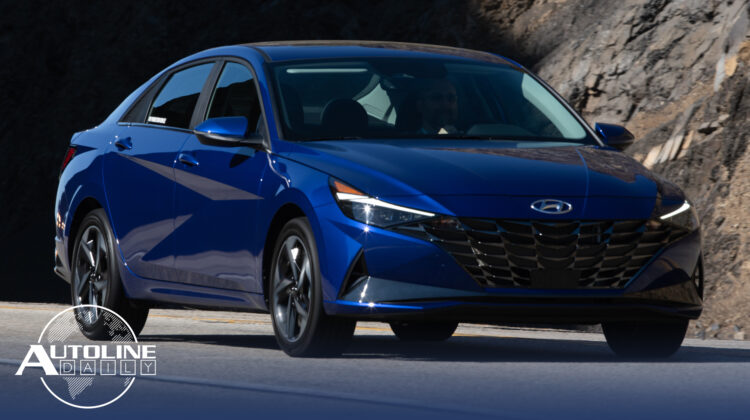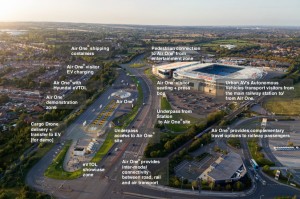

Listen to “AD #3005 – Hyundai Elantra Impressions; GM Plans to Ditch ICEs By 2035; VW Opens 1st EV Battery Recycling Plant” on Spreaker.
Follow us on social media:
Runtime: 10:49
0:08 GM Plans to Ditch ICEs for Light Vehicles By 2035
0:57 Thursday’s Stock Market Results
1:55 Elon Musk Confirms Future Product Details
3:59 A Hack Proof Wiring System?
5:20 Hyundai Second Guesses Apple Partnership
6:04 Daimler’s Operating Profit Better Than Expected
7:03 Hyundai Elantra Impressions
8:28 Hyundai Partners Up to Build VTOL Hub
9:28 Volkswagen Opens First EV Battery Recycling Plantnt
Visit our sponsors to thank them for their support of Autoline Daily: Bridgestone, Intrepid Control Systems, Magna and SAP.
This is Autoline Daily, the show dedicated to enthusiasts of the global automotive industry.
GM PLANS TO DITCH ICEs FOR LIGHT VEHICLES BY 2035
General Motors dropped a bombshell yesterday. It announced it will get rid of its diesel and gasoline engines for light vehicles by 2035. Remember, when we say light vehicles, that still includes its full-size pickups and SUVs. While that’s 14 years away, in automotive terms it’s only two design cycles away, which is right around the corner. GM wants to be completely carbon neutral in its global products and operations by 2040. That’s a very aggressive schedule. A few days ago, Nissan announced it wants to be carbon neutral by 2050, so GM would beat it by a decade. GM will have 30 different BEVs for sale around the world by 2025, and has committed $27 billion to get there.
THURSDAY’S STOCK MARKET RESULTS
The stock market liked what GM had to say, but it didn’t go wild. GM closed up 3.4%. But GM’s strong push into electrics may have caused investors to have second thoughts about EV startups. The entire sector fell, with Nikola plunging 19% and Fisker dropping 7%. Tesla started out Monday at a high of nearly $900 a share, but investors were disappointed with its latest financial numbers and it trended down all week. So investors turned their attention to the automotive supplier sector. Adient, the interior supplier, was up 5%. Aptiv, the software and electronics company, was up over 4%. Magna posted a 3.6% gain and Cooper Standard was up 3%. But the best automotive stock of them all was on the retail side. Carvana jumped 7%.
| STOCK MARKET RESULTS – January 28, 2021 | |||
|---|---|---|---|
| Current Price | $ Change | % Change | |
| General Motors | $51.04 | +$1.70 | +3.4% |
| Nikola | $23.18 | -$5.40 | -18.9% |
| Fisker | $15.46 | -$1.17 | -7% |
| Adiient | $32.91 | +$1.60 | +5.1% |
| Aptiv | $133.42 | +$5.46 | +4.3% |
| Magna | $72.09 | +$2.52 | +3.6% |
| Cooper Standard | $31.31 | +$0.93 | +3.1% |
| Carvana | $256.01 | +$16.70 | +7% |
ELON MUSK CONFIRMS FUTURE PRODUCT DETAILS
Tesla showed off the new versions of the Model S & X and during the company’s fourth quarter earnings call, Elon Musk revealed more details about future products. He confirmed that the Roadster won’t go into production until next year, about two years after it was originally supposed to hit the market. It was delayed in part to focus on the Cybertruck. And speaking of the Cybertruck, Musk says that Tesla will be “lucky” to deliver some this year. Volume production won’t begin until next year. Musk says that they’ve almost finished engineering the Cybertruck but they need to order new manufacturing equipment in order to build it. And speaking of trucks, Elon says they’re ready to start producing semi-trucks but need those 4680 cells to do so. And lastly, Musk said that Tesla plans to introduce an electric commercial van but it too won’t be available until the company can secure the proper battery cell supply for it.
A HACK PROOF WIRING SYSTEM?
We have a great Autoline After Hours posted on our website and YouTube channel. Our guest was Dan Greene from a company called Tueor that developed a hack-proof wiring system that could be used in cars, computers and just about everything else. To convince the Department of Defense how good it is, Tueor invited it to try and hack into one of its computers. Take a look.
“In fact we put out a challenge to the DoD to prove this could work in which we said, ‘Look, here’s a computer and here’s a file and here’s everything you need to know to get into it. We’re going to leave it up online 24-7 until further notice. And if you can get into it we will give you $50,000 and a case of single malt Scotch. One year later I’ve still got the money, but I’ve gone through the Scotch. We had over 490,000 hits from all around the world without a single successful intrusion. And we used that computer in the lab every day.”
John McElroy: “So Dan, who from all over the world tried to hack into your computer?”
Dan Greene: “We had North Korea, China, France, England, a whole bunch of people from the West Coast and a whole bunch of people from the East Coast. We even had a guy from Iceland.”
HYUNDAI SECOND GUESSES APPLE PARTNERSHIP
While there’s been talk of the Hyundai Group partnering up with Apple to make EVs and batteries, it sounds like the automaker is wringing its hands over whether or not to become a contract manufacturer. Hyundai is fairly well vertically integrated, making many of its own components in-house. And Reuters reports a Hyundai executive as saying, “We are not a company which manufactures cars for others. It is not like working with Apple would always produce great results.” And there’s truth in that statement. While companies, like Magna, contract manufactures vehicles for others and make money at it, they also program management and logistics. There’s not a lot of money to be made by simply bolting a bunch of components together.
DAIMLER’S OPERATING PROFIT BETTER THAN EXPECTED
Despite a crazy 2020, Daimler reported a better-than-expected operating profit for the year, thanks to cost cutting measures and car sales picking back up. It’s earnings before interest and taxes or EBIT for 2020 came in at 6.6 billion euros or a little more than $8 billion, which is an increase of 52% compared to 2019. While that’s great news, when its full financial report comes out on February 18th, we expect Daimler’s net profit figure won’t be so sparkling. Daimler also warns that the continued chip shortage and disruptions related to the global pandemic will impact its first quarter results for this year.
HYUNDAI ELANTRA IMPRESSIONS
The 2021 Hyundai Elantra was named the North American Car of the Year. And it’s easy to see why the jury chose it over all the others. Hyundai has a knack for equipping its cars with the latest technology, and pricing them very attractively. We test drove an Elantra with the Limited trim level which comes with standard equipment you might expect on a luxury car. For example: adaptive cruise control, collision avoidance with pedestrian and bicyclist protection, and rear cross-traffic braking. It also had leather trimmed seats, an 8-speaker Bose sound system, and a wireless charging pad for your phone. All that for $26,600. Under the hood is a naturally aspirated 2-liter four with 147 horsepower and 132 pound feet of torque. That power is fed through a CVT which did not exactly deliver crisp shifts and tended to make the engine moan under light throttle. The Elantra rides firmly, but it also transmits every bump and road irregularity into the cabin. We found the new Nissan Sentra to be much better in that regard. Even so, when you consider the entire package, the Elantra is a compelling car to consider for anyone who’s looking for a 5-passenger sedan that delivers 35 miles to the gallon, is nicely equipped and won’t break the bank.
HYUNDAI PARTNERS UP TO BUILD VTOL HUB
We’ve seen a lot of activity involving vertical takeoff and landing aircraft recently but one big thing that’s holding that market back is a lack of infrastructure for VTOLs. That’s why Hyundai, the UK government and the city of Coventry, England have partnered with Urban Air Port, a company that develops infrastructure for future air mobility, to build a hub for VTOLs. The site, which will be located in Coventry, launches later this year and will be used to test and demonstrate the potential of VTOLs for passengers and cargo delivery. The hub is 60% smaller compared to a traditional heliport, can be completely run off the grid and can be installed in just a few days thanks to innovative construction techniques. Urban Air Port plans to install 200 of these sites worldwide over the next five years. Hyundai is supporting the initial hub as part of its goal to commercialize its VTOLs by 2028.
VOLKSWAGEN OPENS FIRST EV BATTERY RECYCLING PLANT
Volkswagen just opened its first facility to recycle electric vehicle batteries that can no longer be reused for other purposes. Initially, the site can recycle up to 3,600 vehicle batteries a year but in the future, it will be scaled up as it optimizes the process. In the long term, it says it will be able to recycle 90% of the battery. In addition to aluminum, copper and plastics, the process yields what’s called “black powder”, which contains valuable raw materials like lithium, nickel, manganese and cobalt. Those materials are then separated by hydrometallurgical processes to be reused for VW’s battery cell production.
But that’s all we got for this week, thanks for watching and we’ll see you again on Monday.
Thanks to our partner for embedding Autoline Daily on its website: WardsAuto.com

John McElroy is an influential thought leader in the automotive industry. He is a journalist, lecturer, commentator and entrepreneur. He created “Autoline Daily,” the first industry webcast of industry news and analysis.







